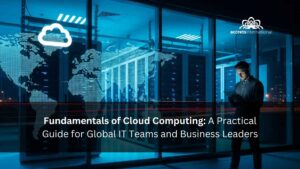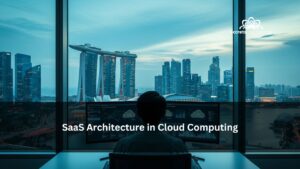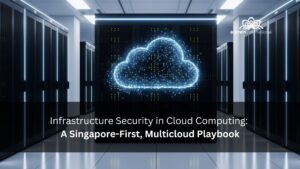A Tier 1 (Tier I) data center is a facility with a single path for power and cooling, no redundancy, and expected uptime of about 99.671%, which equals roughly 28.8 hours of downtime annually. Designed as a basic-capacity environment, Tier 1 data centers are often used by businesses with minimal availability demands. In this guide, we’ll explore how Tier 1 compares to Tier 2, 3, and 4, how it works, who should use it, and what alternatives exist. Let’s go through the tiers together so you can make a well-informed decision by the end.
Table of Contents
ToggleQuick Facts: Tier 1 at a Glance
- Architecture: Single (non-redundant) path for power and cooling
- Redundancy: None (no N+1)
- Maintenance: Preventive work generally means planned downtime
- Typical components: UPS, 24/7 cooling, generator
- Availability math: 99.671% ≈ 28.8 hours/year, ≈ 2.4 hours/month, ≈ ~4.7 minutes/day
If you want the bigger picture of where Tier 1 sits among other tiers, we’ve explained the ladder from Tier I to Tier IV here: https://www.accrets.com/cloud-it/data-center-tiers-definition
Where “Tier 1” Comes From (and Why TIA-942 Is Different)
The data center Tier concept originates with the Uptime Institute, which publishes the Tier Standard and certifies facilities. Many providers say “built to Tier 1,” but certification is separate and involves formal assessment. It’s also useful to note that Uptime Tiers are not the same as TIA-942 ratings, a separate standard covering telecommunications infrastructure. When you’re evaluating a facility in Singapore or the region, ask: is the site Uptime-certified to Tier I, or just designed to those concepts?
For a quick refresher on what each step up the ladder adds, you can also skim our plain-English overview of the tiers: https://www.accrets.com/cloud-it/data-center-tiers-definition
How Tier 1 Works: The Single-Path Architecture
Think of the facility’s power and cooling like a single carriageway road—no parallel lane. In a Tier 1 site:
- Power: One distribution path feeds IT racks. There’s usually a UPS and a generator, but no alternate path to keep IT online if equipment needs service
- Cooling: One cooling loop or route; if you need to service chillers or CRAHs, you’ll likely schedule downtime
- Operations outcome: Because there’s no concurrent maintainability, planned maintenance means planned outage. Unplanned faults can also take everything down because there’s no redundant path to fall back on
A simple mental sketch: one upstream electrical line → one switchboard → one UPS chain → one PDU branch. The same “single path” idea applies to cooling.
Availability Math You Can Use (with SEA Time-Zone Reality)
The headline number for Tier 1 is 99.671% availability. Translate that into downtime you can actually plan around:
- Year: 8760 hours × (1 − 0.99671) ≈ 28.8 hours
- Month (avg): 28.8 ÷ 12 ≈ 2.4 hours
- Day (avg): 28.8 ÷ 365 ≈ 0.079 hours ≈ ~4.7 minutes
A practical planning approach in Singapore: consolidate preventive maintenance into one or two windows a year, often late night or early morning Singapore Time—to minimize user impact across ASEAN time zones. If you run a SaaS with customers in SG, MY, ID, PH, TH and AU, think carefully about regional peaks: an outage window that is quiet in Singapore may still clip business hours in Australia.
Operational Realities in Singapore & Southeast Asia
- Maintenance windows are mandatory at Tier 1
Preventive tasks like UPS battery checks and generator tests often require full shutdowns. Good operators publish a yearly schedule and design around peak avoidance - Tropical climate affects cooling strategy
High humidity and temperatures make cooling load and reliability critical. Systems should be designed for Singapore’s equatorial weather - Compliance pushes many workloads higher
Financial services and government projects often exceed Tier 1 requirements. For example, explore our guide on cloud banking solutions in Southeast Asia or government cloud in Singapore - If you can’t afford downtime, move up
Many mission-critical environments shift to Tier 3, Tier 4, or even Tier 5 infrastructure
Who Should (and Shouldn’t) Choose Tier 1
Good fits:
- SMBs and internal IT teams
- Dev/test and staging environments
- Budget-sensitive or short-term projects
Poor fits:
- Customer-facing apps with tight SLAs
- Workloads requiring compliance or auditability
- Always-on or regionally distributed platforms
Explore cloud banking or public sector cloud needs here to gauge Tier needs for your industry.
Tier-by-Tier Comparison: Paths, Redundancy, Uptime, Downtime
| Tier | Paths for Power/Cooling | Redundancy | Availability | Downtime (Annual) | Maintenance |
| I | Single | None | 99.671% | ~28.8 hrs | Shutdown |
| II | Single + partial N+1 | Partial | 99.741% | ~22 hrs | Likely |
| III | Multiple, N+1 | Full | 99.982% | ~1.6 hrs | None |
| IV | Fully redundant | 2N/2N+1 | 99.995% | ~0.4 hrs | None |
Tiers vs TIA-942 (And Other Labels You’ll Hear)
Uptime Institute’s Tiers focus on topology and operations. TIA-942, by contrast, centers on telecom infra. The two are not interchangeable. When comparing data centers in Singapore or Southeast Asia, ask whether a facility is certified by Uptime, and confirm what level the label represents.
You can also explore the advantages of IaaS or understand the difference between IaaS and PaaS to see how infrastructure choices impact service levels.
Decision Checklist: 10 Questions Before Picking Tier 1
- What SLA target are you committing to?
- Can you accommodate 1–2 site-wide shutdowns a year?
- Do you have a DR plan and tested backups?
- What are your RTO/RPO goals?
- Are compliance standards a concern?
- Is your team trained to manage outages?
- Will you need managed services or go DIY?
- Do you have observability and monitoring in place?
- How does cost savings compare to risk exposure?
- Is this a stepping stone to Tier 3 later?
If you’re unsure, consider IT DR-as-a-Service or Managed Backup Services to offset downtime risks.
Adjacent Choices If Tier 1 Isn’t Enough
Many enterprises use Tier 3 data centers as a base standard in Singapore. If you’re reducing hands-on effort, explore managed IT services or upgrade to on-premise private cloud. For edge cases or China delivery, see Teridion
When to Talk to an Expert (Promotion Section)
Tier 1 delivers basic capacity but comes with trade-offs in uptime and operational flexibility. Many Singapore-based teams opt for Tier 3 to balance cost, availability, and compliance.Accrets operates a Tier 3 private data center and helps teams in Singapore and Southeast Asia design infrastructure aligned to risk and budget. Book a free consultation with an Accrets cloud expert here: https://www.accrets.com/contact-us/
Need full-service support? Explore our Managed IT Services
Dandy Pradana is an Digital Marketer and tech enthusiast focused on driving digital growth through smart infrastructure and automation. Aligned with Accrets’ mission, he bridges marketing strategy and cloud technology to help businesses scale securely and efficiently.




